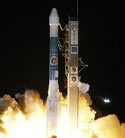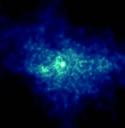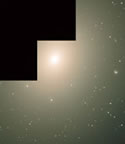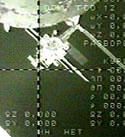A powerful Ariane 5 rocket lifted off late Friday from the European Space Agency (ESA) launch center in Kourou, French Guiana. It was carrying two satellites: the STELLAT 5 which will provide Internet and video transmission to Europe, Africa and the Middle East; and the N-STAR C which will support mobile phones in Japan. This is the 12th launch of an Ariane 5.
Russians Propose Human Mars Mission
Russian space officials have announced their intentions to send human explorers to Mars by 2015. Hoping for International support to help fund the $20 billion budget, managers have already planned out the mission basics. They’re estimating that two ships would travel to Mars and deliver three people to the surface for 440 days while three others would remain in orbit. Obviously this is completely preliminary in nature, and officials from NASA or the ESA have yet to comment if they would support this Russian initiative.
CONTOUR Comet Mission Launches

Image credit: NASA
NASA’s Comet Nucleus Tour (CONTOUR) spacecraft launched successfully on board a Boeing Delta II rocket this week. Designed by the John Hopkins University Applied Physics Laboratory, the 970 kilogram spacecraft was placed into an elliptical orbit 63 minutes after launch. CONTOUR will orbit Earth until August 15, when it will fire its main engine and begin chasing Comets Encke and Schwassmann-Wachmann 3. If all goes as planned, the spacecraft will get as close as 100km from each comet’s nucleus.
NASA?s Comet Nucleus Tour (CONTOUR) spacecraft ? set to provide the closest look yet at the ?heart? of a comet?successfully launched today at 2:47 a.m. EDT aboard a Boeing Delta II rocket from Cape Canaveral Air Force Station, Fla.
Designed and built by The Johns Hopkins University Applied Physics Laboratory (APL) in Laurel, Md., the 2,138-pound (970-kilogram) spacecraft was placed into an elliptical Earth orbit 63 minutes after launch. About 19 minutes later the mission operations team at APL acquired a signal from the spacecraft through the Deep Space Network antenna station in Goldstone, Calif., and by 5:45 a.m. EDT Mission Director Dr. Robert W. Farquhar of the Applied Physics Lab confirmed the craft was operating normally and ready to carry out its early orbit maneuvers.
?CONTOUR?s launch was a spectacular start to an important project,? says Dr. Stamatios M. Krimigis, head of the APL Space Department. ?CONTOUR is next in the growing lineup of missions to explore small planetary bodies ? such as comets and asteroids ? and we expect it will add much to what little we know about these ancient samples of the solar system?s original materials.?
CONTOUR will orbit Earth until Aug. 15, when it?s scheduled to fire its main engine and enter a comet-chasing orbit around the sun. The mission?s flexible four-year plan includes encounters with comets Encke (Nov. 12, 2003) and Schwassmann-Wachmann 3 (June 19, 2006), though it can add an encounter with a ?new? and scientifically valuable comet from the outer solar system, should one be discovered in time for CONTOUR to fly past it. CONTOUR?s four scientific instruments will take detailed pictures and measure the chemical makeup of each comet?s nucleus ? a chunk of ice and rock ? while analyzing the surrounding gas and dust.
The 8-sided solar-powered craft will fly as close as 62 miles (100 kilometers) from each nucleus, protected by a 10-inch-thick, layered dust shield of heavy Nextel and Kevlar fabric. Scientists expect the data to reveal the differences between comet nuclei and answer questions about the role comets had in shaping the Earth and other planets.
?We?re looking forward to a fantastic mission,? says APL?s Edward L. Reynolds, who at launch assumed the role of CONTOUR project manager from Mary C. Chiu, who is retiring from the Applied Physics Laboratory. ?From mission design and operations at APL, to the navigation group at NASA?s Jet Propulsion Laboratory, to the science effort headed by Cornell University, this team includes the talent and expertise needed to capture and deliver the best data yet on a comet?s nucleus.?
The $159 million CONTOUR is the sixth mission in NASA?s Discovery Program of lower cost, scientifically focused exploration projects. APL manages the mission, built the spacecraft and its two cameras, and will operate CONTOUR during flight. NASA?s Goddard Space Flight Center, Greenbelt, Md., provided CONTOUR?s neutral gas/ion mass spectrometer and von Hoerner & Sulger, GmbH, Schwetzingen, Germany, built the dust analyzer. NASA?s Jet Propulsion Laboratory, Pasadena, Calif., will provide navigation and Deep Space Network (DSN) support. Dr. Joseph Veverka, CONTOUR?s principal investigator from Cornell University, Ithaca, N.Y., leads a science team of co-investigators from universities, industry and government agencies in the U.S. and Europe.
Original Source: NASA News Release
Chandra Finds a Bull’s Eye Pulsar

Image credit: Chandra
The newest image taken with the Chandra X-Ray Observatory is of distant supernova remnant SNR G54.1+0.3. The object contains a ring of high-energy particles which is created by a rapidly spinning central neutron star. Because it spins 7 times a second, the neutron star has created an enormous electric field which accelerates particles near the star and produces jets which blast away from the poles.
The Chandra image of the distant supernova remnant SNR G54.1+0.3 reveals a bright ring of high-energy particles with a central point-like source. This observation enabled scientists to use the giant Arecibo Radio Telescope to search for and locate the pulsar, or neutron star that powers the ring. The ring of particles and two jet-like structures appear to be due to the energetic flow of radiation and particles from the rapidly spinning neutron star rotating 7 times per second.
During the supernova event, the core of a massive star collapsed to form a neutron star that is highly magnetized and creates an enormous electric field as it rotates. The electric field accelerates particles near the neutron star and produces jets blasting away from the poles, and as a disk of matter and anti-matter flowing away from the equator at high speeds. As the equatorial flow rams into the particles and magnetic fields in the nebula, a shock wave forms. The shock wave boosts the particles to extremely high energies causing them to glow in X-rays and produce the bright ring (see inset).
The particles stream outward from the ring and the jets to supply the extended nebula, which spans approximately 6 light years.
The features observed in SNR G54.1+0.3 are very similar to other “pulsar wind nebulas” found by Chandra in the Crab Nebula, the Vela supernova remnant, and PSR B1509-58. By analyzing the similarities and differences between these objects, scientists hope to better understand the fascinating process of transforming the rotational energy of the neutron star into high-energy particles with very little frictional heat loss.
Original Source: Chandra News Release
Young Stars in an Old Galaxy

Image credit: Hubble
Astronomers have spotted a number of young stellar clusters dotted around a very old elliptical galaxy – this disputes the established theory that old galaxies contain only older stars. The team used the Hubble Space Telescope and the ESO Very Large Telescope to take a series of images of galaxy NGC 4365, and they were able to identify star clusters that were only a few billion years old, while the majority were over 12 billion years old. Why the galaxy contains such a combination of young and old stars is still a mystery.
Combining data from the NASA/ESA Hubble Space Telescope and the ESO Very Large Telescope (VLT), a group of European and American astronomers have made a major discovery. They have identified a huge number of ‘young’ stellar clusters, in an old elliptical galaxy.
For the first time, it has been possible to identify several distinct periods of star formation in a galaxy as old as this one. Elliptical galaxies have always been considered to have undergone one early star-forming period and thereafter to be devoid of star formation. However, the combination of the best and largest telescopes in space and on the ground has now clearly shown that there is more than meets the eye.
Do elliptical galaxies only contain old stars?
One of the challenges of modern astronomy is to understand how galaxies – large systems of stars, gas and dust – form and evolve. When did most of the stars in the Universe form? Did this happen at a very early stage, within a few billion years of the Big Bang? Have a significant number of the stars we now observe formed much more recently?
Spectacular collisions between galaxies take place all the time, triggering the formation of thousands or even millions of stars. However, when looking at the Universe as a whole, most of its stars are found in elliptical galaxies whose overall appearance has so far led us to believe that they, and their stars and as well, are old.
These elliptical galaxies do shine with the diffuse, reddish glow normally associated with stars that are many thousand million years old. However, what is the underlying mix of stars that produces this elderly appearance? Could a significant number of much younger stars be ‘hiding’ among the older ones?
Detailed observations with the world’s premier telescopes have now cast new light on this central question about the behaviour of some of the major building blocks of the Universe.
Cosmic paleonthology
To break the stellar ‘cocktail’ in elliptical galaxies down into its different constituents, a team of European and American astronomers observed massive stellar clusters in and around nearby galaxies. These “globular” clusters, so called because of their shape, exist in large numbers around all observed galaxies and form a kind of ‘skeleton’ within their host galaxies. These ‘bones’ receive an imprint for every episode of star formation they undergo. By reading the ages of the globular clusters in a galaxy, it is possible to identify the past epoch(s) of active star formation in a galaxy.
Reading the imprints and deducing the distribution of ages of the globular clusters, astronomers can reveal when many of the stars in elliptical galaxies formed. This is similar to the way a palaeontologist uses the skeletons of dinosaurs to deduce information about the era in which they lived.
A surprising discovery
The team combined images of a number of galaxies from Hubble’s Wide Field and Planetary Camera 2 with infrared images obtained from the multi-mode ISAAC instrument on the 8.2m VLT Antu telescope at the ESO Paranal Observatory (Chile). To their great surprise, they discovered that many of the globular clusters in one of these galaxies, NGC 4365, a member of the large Virgo cluster of galaxies, were only a few thousand million years old, much younger than most of the other stars in this galaxy (roughly 12 thousand million years old).
The astronomers were able to identify three major groups of stellar clusters. There is an old population of clusters of metal-poor stars, some clusters of old but metal-rich stars and now, seen for the first time, a population of clusters with young and metal-rich stars.
These results have been fully confirmed by spectroscopic observations made with another of the world’s giant telescopes, the 10-metre Keck on Hawaii.
“It is a great pleasure to see two projects wholly or partly funded by Europe – VLT and Hubble – work in concert to produce such an important scientific result”, says Piero Benvenuti, ESA Hubble Project Scientist. “The synergy between the most advanced ground and space telescopes continues to prove its effectiveness, paving the way to impressive new discoveries that would not otherwise be possible.”
The discovery of young globular clusters within old galaxies is surprising since the stars in the giant elliptical galaxies were until now believed to have formed during a single period early in the history of the Universe. It is now clear that some of the galaxies may be hiding their true nature and have indeed experienced much more recent periods of major star formation.
Original Source: ESA News Release
Progress Cargo Ship Launches

Image credit: NASA
A Progress supply ship lifted off from the Baikonur Cosmodrome in Kazakhstan on Wednesday to deliver fuel, supplies and equipment to the International Space Station. The Progress 8 spacecraft is scheduled to dock with the station early Saturday. The docking port that the Progress will use was vacated on Tuesday by the station’s previous Progress cargo ship, now filled with garbage. It was de-orbited and burned up in the Earth’s atmosphere.
A Russian Progress resupply craft was successfully launched today from the Baikonur Cosmodrome in Kazakhstan to bring fuel, supplies and equipment to the International Space Station.
The Progress 8 spacecraft lifted off on a Soyuz rocket at 12:37 a.m. CDT. About nine minutes later its solar rays and navigational antennas deployed in response to preprogrammed commands, and the umpiloted cargo carrier was safely in orbit.
Progress 8 is scheduled to dock with the space station early Saturday, where Expedition 5 crewmembers, Commander Valery Korzun, Astronaut Peggy Whitson and Cosmonaut Sergei Treschev, will begin unloading its cargo. The Progress can carry about 7,000 pounds into orbit, including fuel for the Zvezda Service Module’s attitude control thrusters.
A series of rendezvous burns by the Progress 8 engines over the next three days will result in its docking to the aft port of the Zvezda Service Module at about 1:25 a.m. CDT Saturday over Central Asia. That port was vacated Tuesday when the Progress 7 was undocked with its load of trash and deorbited to a fiery destruction in the Earth’s atmosphere.
Original Source: NASA News Release
NASA Finds Tiny Cracks in Shuttle Fuel Lines
NASA controllers decided to ground the shuttle fleet this week when they discovered tiny fuel line cracks. The first crack was uncovered during a routine examination of Atlantis, so the other shuttles were analyzed and additional cracks were found in Discovery as well. Industry experts applaud NASA’s decision to ground the fleet; since the Challenger disaster in 1986, NASA has put a greater emphasis on safety.
Open the pod bay door Universe Today
I think I’ve finally got everything working properly now, so I wanted to take moment and explain what happened Wednesday night (hereafter we’ll call it Evil Wednesday) when Universe Today took on a mind of its own and went on an email rampage. Around 8:00pm my time my Internet hosting provider started resending emails it had already sent through its mail system, including 12 versions of Universe Today. I contacted technical support and their only solution to stop this from happening was for me to delete the entire mailing list.
So I did (I had a backup). Then they recommended that I rebuild it again. So I did, which was when everyone on the list should have received a “Welcome to Universe Today” email. Don’t worry, you aren’t going to get an extra newsletter, you’re still just subscribed once. Unfortunately I think a few hundred people misunderstood, and unsubscribed from the newsletter. 🙁
My webhost accepted responsibility for the problem – it was totally their fault, not a virus, or problem on my end (whew). Unfortunately, they’re not entirely sure why it happened, but they’re still looking into it. So, there isn’t much I can do but hope that it doesn’t happen again.
Thanks for your support, here’s an adorable picture of my now 8-month old daughter to help distract you from the cramps in your delete finger.
Asteroid Narrowly Misses the Earth
An asteroid the size of a football field came extremely close to the Earth last week, and scientists didn’t even know until after it passed us by. Asteroid 2002 MN is 100 metres in diameter and passed by us at a distance of only 120,000km, less than one-third the distance from the Earth to the Moon. This is one of the closest near-misses ever recorded of a spacerock this size; had it actually struck the planet it would have cause considerable destruction and loss of life.
Endeavour Lands in California
After two extra days in space, Endeavour finally touched down at Edwards Air Force Base in California on Wednesday. The landing had been delayed because of thunderstorms at the Florida landing strip. During the shuttle’s 14 days in space, the astronauts delivered a new crew to the International Space Station and performed three spacewalks to install new hardware. The shuttle will now be mounted onto the back of a specially modified 747 and flown back to Florida to prepare for its next launch.
